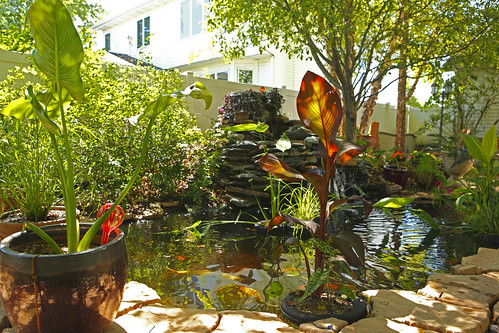Decide first what part of the backyard you want to
your fish pond to be situated before going out and
buying anything. Select an area where it is far from
the trees since many aquatic plants, like lilies, need
a sufficient amount of sunlight to grow.
Choose an area where there are no falling leaves that
can make cleaning a nightmare. Do not place your pond
on low areas since large volumes of rainwater might
run off and accumulate in the pond during rainy
seasons. Not to mention, these runoff water might
contain fertilizers, pesticides, and other harmful
materials.
Place your pond in an area where it can be best
appreciated and seen. The sense of building a pond is
for you to enjoy it. Select a location where it can be
best viewed (i.e. the sitting area or a patio in the
garden).

Types of Pond
After choosing where you want your pond to be located,
it is now time to select what type of pond you want.
The two types of pond are the following:
ABS plastic preformed ponds are usually used for small
ponds that can contain up to 250 gallons of water.
This type of pond comes in a variety of sizes and
shapes such as hourglass, rock gardens, and kidney.
Waterfalls and formed spillways are also available.
Pond lines or liners are used for any size of pond.
The sizes available for this kind of pond is 10’ x 15’
to 20’ x 25’ or larger. This can allow you to build a
pond to your preferred size either by using them
individually or by connecting together two or more pod
liners with a special adhesive.
These pond liners are very heavy especially the large
ones. They are usually made of rubber. Using pond
liners can be quite a fun and creative experience
since this type may allow you to decide on the shape
of your pond. However, you need to be aware that a 19’
x 26’ liner will not create a pond of the same size.
In choosing the proper size liner, it is imperative to
know the width (W), length (L), as well as the maximum
depth (MD) at their widest points. After which, use
the formula L+(MD*2) by W+(MD*2).
This means that a 10 foot long by 5 foot wide by 2
foot deep pond may require a 14’ x 9’ pond liner so as
to make an edge above the water level. It is important
to let a professional pond developer help in
determining the pond size liner you need.
Dig It
Now that you’ve decided on the location and the type
of your fish pond, it is time to dig it. The average
size of the pond is at least 18" deep at its deepest
point. However, 24" is better. With this depth, the
fishes may be allowed to stay in the pond during
winter time without freezing. Inclusion of planting
shelves in the design will make it easier to place
emergent lilies and plants.
Filtering
After accomplishing the above tasks, it is high time
for you to think about filtration. It may be better to
ask your pond professional about this topic. Just keep
in mind that whichever filter you choose, ensure that
it is cleaned at a regular basis so that the water
will remain clear. Utilizing a filter may also hinder
the mosquitoes from making the pond their breeding
ground.
All Set
And now, all you have to do is add your fish and you
are good to go! All the beauty and enjoyment that you
will have for yourself, friends and family as you entertain
and enjoy your backyard with your new pond.

Dan and Deanna "Marketing Unscrambled"
1 comment:
Can't get a better one. simply superb..how can really shared a stuff on pond in these emerging IT world..keep it up!
Sample Marketing Questionnaire
Post a Comment